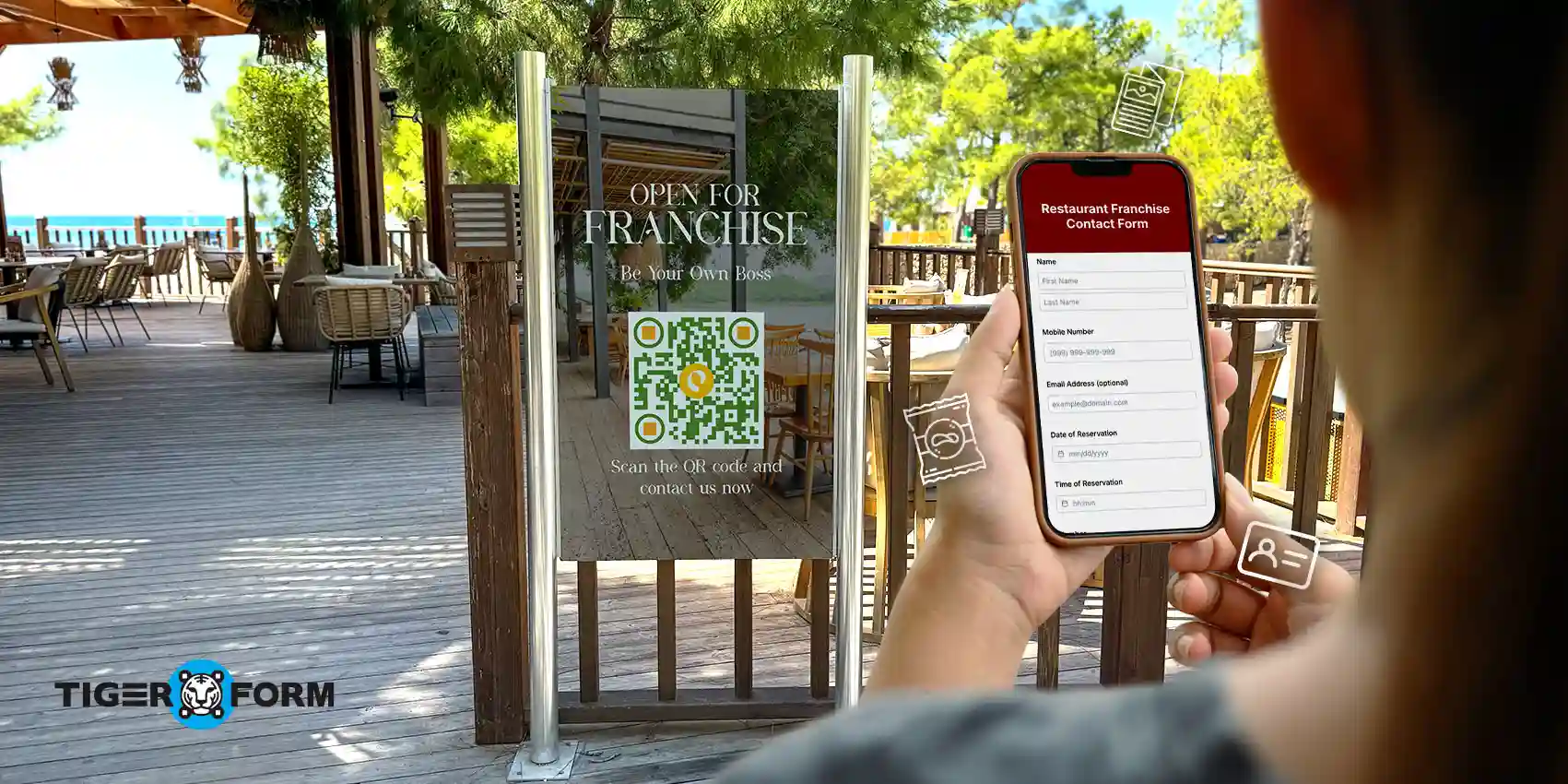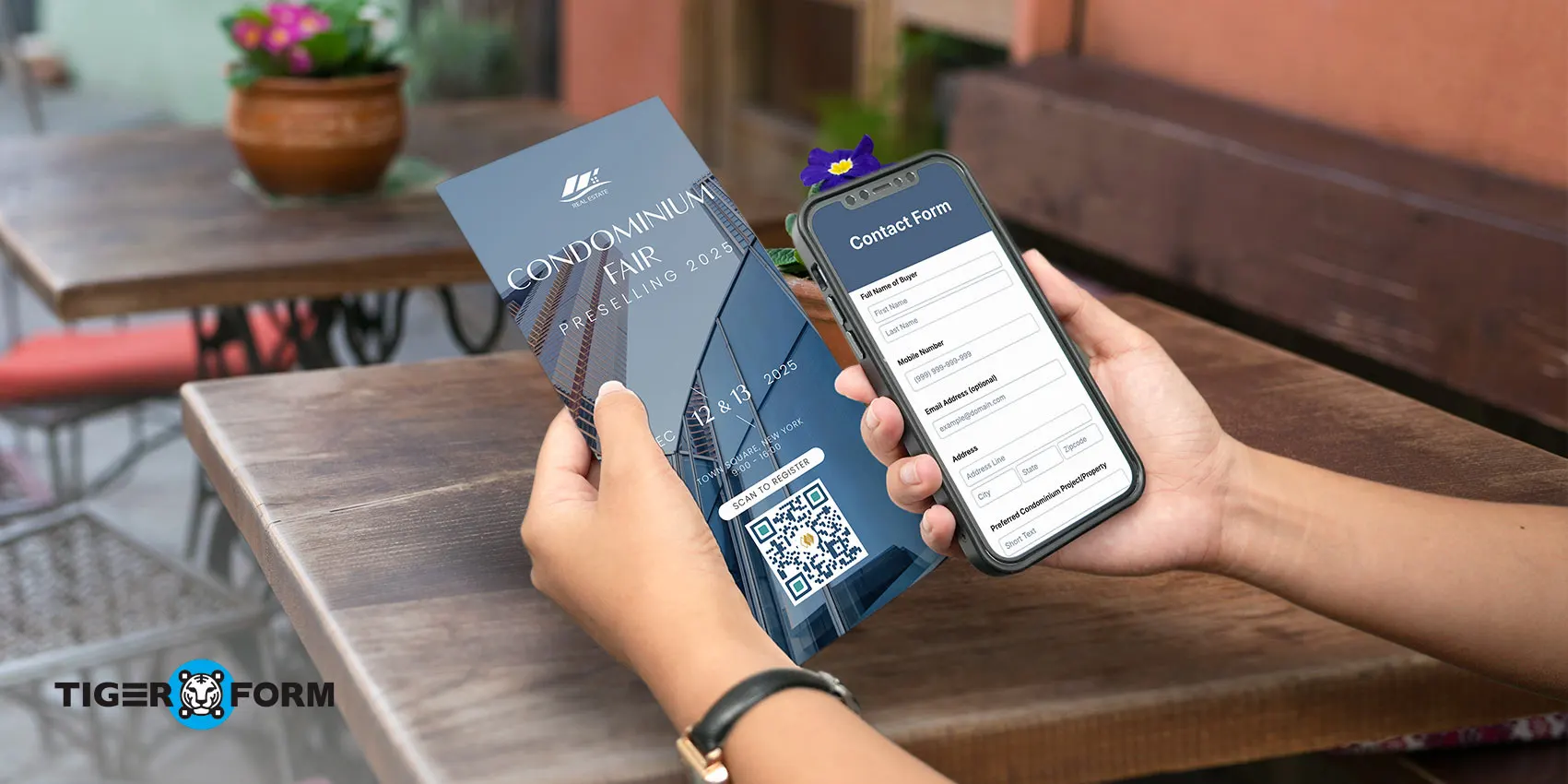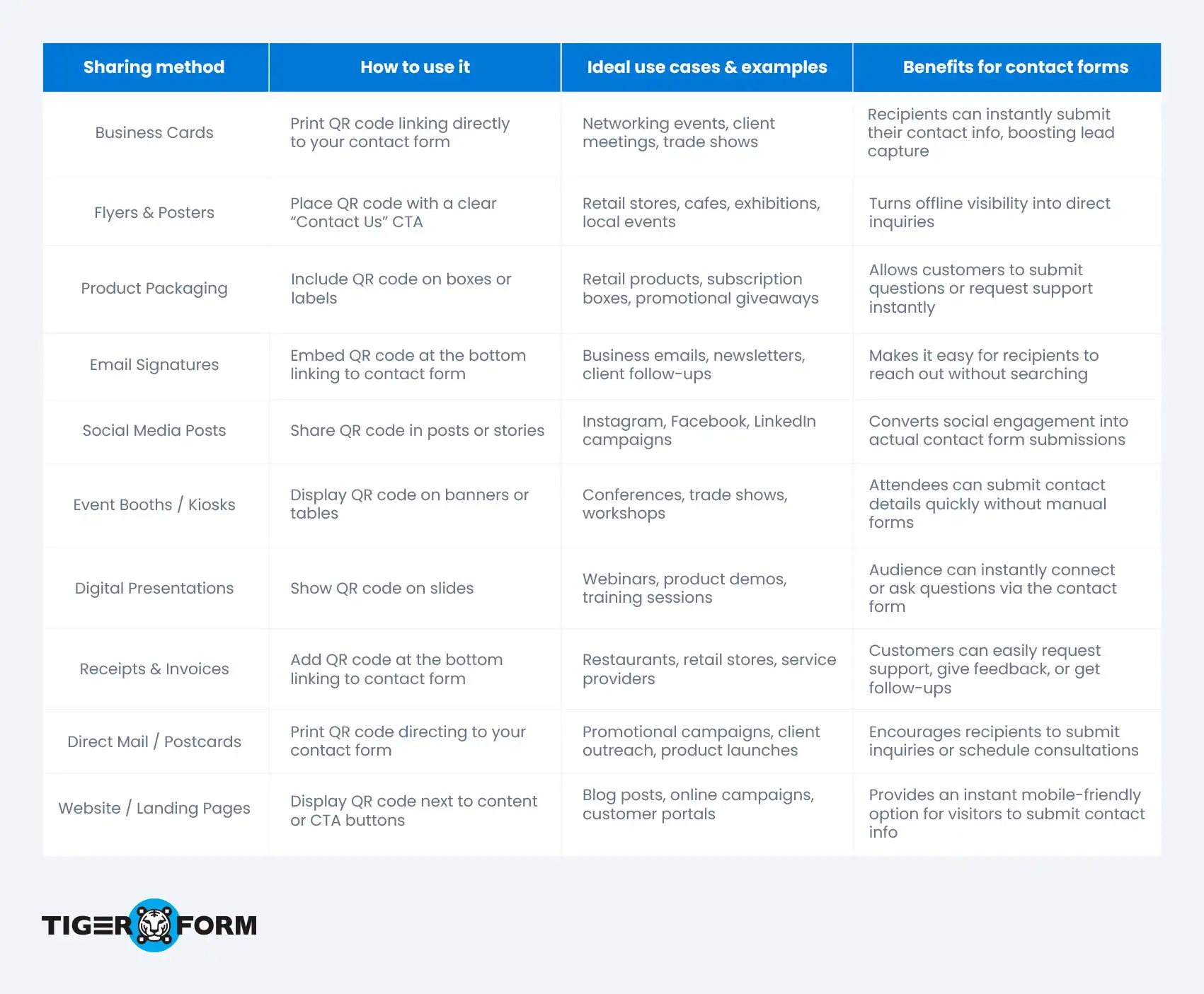
QR code for contact forms is the fastest way to make it easier for people to reach you. It’s one of those simple shifts that makes you wonder why you didn’t try it sooner. They remove friction from the process and make connecting as easy as pulling out a phone. You can add a QR code to business cards, posters, product packaging, or event booths and instantly connect offline audiences to your online form. This small change makes a big difference.
In this guide, you’ll find 15 solid reasons why switching to a QR code will save time, boost responses, and make your communication smoother than ever. Also, learn to generate a QR code for contact form with a form creator.
15 reasons to switch to QR code for contact form
1. Instant access to form
QR codes remove the biggest barrier between your audience and the contact form: typing. Instead of asking people to enter a long URL on their phone, a single scan pulls the form up instantly. This direct access eliminates errors, saves time, and keeps people from dropping off before they even start. The smoother the path, the more likely they’ll complete and submit your form.
2. Higher response rates
When filling out a contact form is effortless, more people do it. A QR code cuts down every extra step of typing, searching, etc. Just a quick scan and the form is ready to complete. This simplicity translates into higher engagement and more responses. If you’re collecting leads at an event or feedback in-store, form sharing with a QR code makes participation almost automatic.
3. Perfect for business cards
Most business cards get lost in wallets or drawers, and the tiny printed details are often ignored. Adding a QR code that links directly to your contact form changes that. Instead of manually typing your email or phone number, people can scan it once and instantly reach you through the form. It turns a static card into an interactive tool, making follow-ups smoother and far more likely to happen.
4. Works anywhere—online and offline
A contact form link only works when people are online, but a QR code bridges both worlds. You can print it on flyers, posters, product packaging, or business cards; people can still scan and reach your form instantly. This makes it far more versatile than just dropping a link. No matter where your audience sees it, the QR code becomes a direct doorway to your contact form.
5. Easy to track and measure
One big advantage of using a QR code for a contact form is the data you get back. Every scan can be tracked, giving insights into when, where, and how often people engage. Pair that with form submissions, and you can measure conversion rates with real numbers. Unlike paper forms or plain contact details, QR codes give you clear analytics to see what’s working.
6. No printing limits
Traditional contact details on flyers or posters lock you in. If your phone number or email changes, all that material is wasted. A QR code for the contact form solves this problem. The code itself doesn’t change, but you can update the form behind it anytime. That means you can keep using the same posters, business cards, or brochures while ensuring people always reach the right, up-to-date contact form.
7. Faster event check-ins
At events, time is critical. Passing around paper forms or asking attendees to type a link slows everything down. QR codes let people instantly scan and submit their information from their phones. This speeds up check-ins, reduces queues, and ensures accurate data capture.
8. Works across multiple channels
The contact form QR code isn’t limited to one media type. You can use it on business cards, flyers, posters, product packaging, emails, social media posts, and presentation slides. This flexibility means your audience can effortlessly access your contact form wherever they see your brand, whether it’s offline or online channels. It makes your form more discoverable and increases the chances people will fill it out.
9. Saves time for you and your audience
Collecting contact information manually or sharing long links takes time for both parties. A QR code streamlines the process: users scan, fill out the form, and submit in seconds. You save time sorting responses, and they save time accessing and submitting the form. It’s a simple change that makes connecting faster, more efficient, and less frustrating for everyone involved.
10. Enhances professionalism
Using a QR code form shows that your business is modern and organized. Instead of handing out paper forms or long URLs, a clean QR code on marketing material communicates efficiency and attention to detail. It gives a professional impression and signals that connecting with you is simple, quick, and technologically up-to-date.
11. Customizable for branding
QR codes aren’t just black-and-white squares anymore. You can customize them with your brand colors, logo, or a call-to-action that matches your business style. A QR code branding on your contact form makes it instantly recognizable and encourages people to scan it, creating a professional and cohesive look across all your marketing materials.
12. Ideal for marketing campaigns
A QR code contact form can turn any marketing material into an interactive experience. Include it in social media posts, email campaigns, posters, or product packaging; people can instantly reach your form. This makes campaigns more engaging, increases lead capture, and ensures your audience has a simple way to connect, no matter where they see your message.
13. Easy to update forms without reprinting
With dynamic QR codes, you can update or change the contact form linked to the code anytime, without redoing your printed materials. Your business cards, flyers, or posters stay relevant even if your form changes. It saves money, reduces waste, and ensures your audience always accesses the most current version of your contact form.
14. Collects accurate information
Paper forms or manual sharing methods often lead to incomplete or messy entries. With a QR code directing users to your contact form, submissions are structured and complete, ensuring you collect accurate information every time. This makes follow-ups easier, improves data quality, and reduces the need for clarifications or corrections.
15. Works in any environment
A QR code contact form can be used indoors, outdoors, at events, in stores, or on packaging. Unlike paper forms that can get lost or links that require a device and connection, QR codes make contact forms accessible in every environment. This flexibility ensures people can reach you anytime, anywhere, maximizing your chances of collecting responses.

Create a QR code for your form easily with a form creator
TIGER FORM is an intuitive online form builder designed to make creating digital forms simple, fast, and professional. It lets you build your form with drag-and-drop functionality, pre-designed templates, and customization options. It’s one of the best form generator, perfect for businesses, events, or personal use. One of its standout features is the ability to generate a QR code for your form so users can access it instantly with a scan.
Here’s how you can create a QR code for a contact form using TIGER FORM:
Step 1: Sign in and create your form
Log in to TIGER FORM, start a blank form, or select a ready-made contact form template. Customize fields as needed (name, email, message, etc.).
Step 2: Save and get the form link
Once your contact form is ready, save it and copy the shareable link provided by TIGER FORM.
Step 3: Generate the QR code
Use TIGER FORM’s built-in QR code generator. Paste your form link, and the platform will create a QR code instantly.
Step 4: Customize the QR code (Optional)
Add colors, a logo, or a frame to match your branding. TIGER FORM lets you make the QR code visually appealing without affecting functionality.
Step 5: Share or print
Download the QR code and place it wherever your audience can scan it: business cards, flyers, posters, product packaging, or digital channels. Now, anyone can access your contact form instantly with a single scan.
Best ways to share your contact form QR code

Common mistakes to avoid
1. Using low-quality or pixelated QR codes
A blurry or low-resolution QR code can be difficult or impossible to scan. Whether it’s on a printed flyer, poster, or business card, this reduces the chances that users will access your contact form, leading to lost leads and frustrated potential contacts.
2. Not testing before publishing
Many people skip testing, assuming the QR code works. Always scan it on multiple devices and apps to confirm it opens the correct contact form. Testing ensures that your audience won’t face errors or broken links when trying to submit their information.
3. Linking to a broken or expired form
The QR code becomes useless if your form link expires or is deleted. Users scanning it will encounter errors, which can harm your credibility and reduce engagement. Always verify that your form is active and properly hosted.
4. Over-styling QR codes
Customizing QR codes with logos, colors, or shapes is tempting for branding, but too much styling can make the code unreadable by scanners. Keep design changes subtle while maintaining the code’s scannability.
5. Ignoring mobile optimization
Most users scan QR codes with smartphones, so if your contact form isn’t mobile-friendly, it will be difficult to complete. Ensure your form layout, fields, and buttons work perfectly on small screens.
6. Placing QR codes in hard-to-scan locations
Avoid printing codes on curved surfaces, reflective materials, or low-contrast backgrounds. Codes need to be clearly visible and easy to scan from a reasonable distance.
7. Failing to include a clear call-to-action
Simply placing a QR code without instructions can confuse users. Add a short message like “Scan to Contact Us” so people understand exactly what they’ll get by scanning the form QR code.
8. Using static QR codes for frequently updated forms
Static QR codes link to a fixed URL. Static codes may point to outdated forms if your contact form changes frequently. Using a dynamic QR code lets you update the form without reprinting the code.
Share your contact form anywhere with a QR code today
Accessibility matters more than ever. When someone wants to reach you, they shouldn’t be slowed down by typing, searching, or waiting for pages to load. A QR code for contact form cuts through all that, delivering a smooth, one-scan experience. What really sets it apart is how versatile and future-ready it is.
Your contact form works everywhere your audience is, just a scan away. All you need to do is to use a reliable form generator like TIGER FORM to build your contact form and generate a QR code in minutes.
Start today and give your audience a faster, smoother way to get in touch.
FAQs
1. How do I create a QR code for a form?
You can generate a QR code by copying your form’s share link and pasting it into a free online QR code generator. The generator will instantly create a QR code that you can download and share.
2. Is Google QR code free?
Yes. Google’s built-in QR code feature is free to use. You can create QR codes for links, forms, or other content directly from Chrome or Google Drive without paying anything.
3. Can I customize the design of my QR code?
Yes. Many QR code generators, like TIGER FOR,M let you change colors, add logos, or adjust shapes to match your brand style. Just make sure the final code is still easy to scan.
4. Where can I use my QR code form?
You can place your QR code on posters, event flyers, product packaging, receipts, business cards, or even in social media posts. This makes it easy for people to scan and fill out your form instantly.
